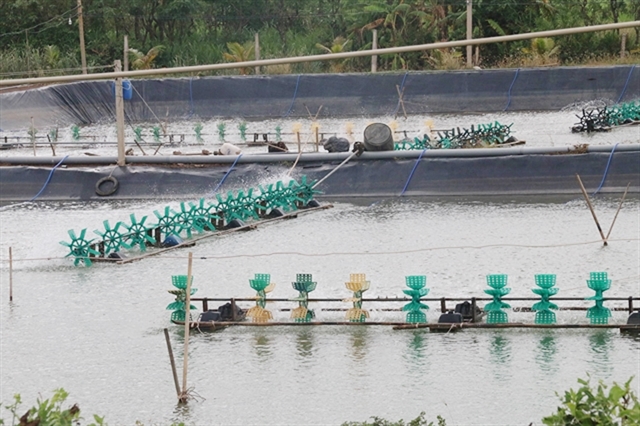 |
| Tiền Giang Province aims to develop aquaculture into a leading economic sector by expanding marine farming areas and implementing strategic development plans. — VNA/VNS Photo Minh Trí |
TIỀN GIANG — The Mekong Delta province Tiền Giang plans to expand its marine farming area by 14,700 hectares this year with a projected output of over 200,000 tonnes as it hopes to turn aquaculture into a key economic sector.
Tiền Giang has high potential to foster aquaculture growth, having an optimal geographical condition and being surrounded by major rivers like Soài Rạp and Cửa Tiểu, according to director of the provincial Department of Agriculture and Rural Development Nguyễn Văn Mẫn.
The province hopes to develop local aquaculture towards adapting to climate change, enhancing productivity, and providing jobs for locals, especially in coastal and Đồng Tháp Mười alum-intruded areas which have extreme weather conditions.
Local authorities will design more aquafarming models that can respond to climate change in freshwater, saltwater, and brackish water areas, as well as form concentrated farming areas and create quality products for domestic consumption and export.
Tiền Giang has also developed different shrimp farming models in coastal areas like Gò Đông Công and Tân Phú Đông Districts, including extensive farming, intensive farming, shrimp-rice, and two- or three-stage high-tech models.
The shrimp-rice farming model breeds shrimp in the dry season and grows rice in the rainy season in the same fields, while the two or three-stage high-tech model involves one phase of nursery of 20 days and one or two phases of commercial farming.
 |
| Applying high-tech, diversified farming models and encouraging sustainable practices would be crucial for the province to foster aquaculture growth. — VNA/VNS Photo Minh Trí |
In Tân Phú Đông District, certain concentrated aquafarming models have been established to farm shrimp and other aquatic species with high economic value.
They include the Nam Gò Công farm in Phú Tân Commune, 30-hectare and 352-hectare high-tech farms in Cồn Cống Village (Phú Tân Commune), as well as a 230-hectare farm in Phú Đông Commune.
Gò Công Đông District plans to combine marine aquaculture and tourism in the Bắc Gò Công shrimp farming area and a 2,200-hectare clam farming area in Tân Thành Commune.
Upstream areas like Cái Bè District, Cai Lậy District, and Cai Lậy Town have also focused on raising freshwater species with high economic value such as yellow catfish, pangasius, barb, and carp, while providing fish seeds and breeding aquarium fish.
Tiền Giang Province has been teaching farming techniques and providing technology to farmers, along with expanding aquafarming models that bring high economic efficiency, to protect the environment and the local ecosystem and bolster the general aquaculture landscape.
Mẫn said authorities have also encouraged farmers to apply several green, eco-friendly models to foster sustainable aquafarming coupled with climate change adaptation and carbon footprint reduction, which in turn creates more safe and environmentally-friendly products.
In terms of shrimp farming, the province expects to increase the two or three-period models to 320 hectares, accounting for 15 per cent of the total intensive farming area.
Cai Lậy Town has been building a biosafety frog farming model in Tân Phú Commune and a similar eel farming model in Tân Phú, Mỹ Hạnh Đông, Mỹ Phước Tây, and Thanh Hòa Communes.
In 2024, it will continue to evaluate the efficiency of each model and provide farmers with essential technologies for further development.
The Cai Lậy District Centre for Agricultural Extension and Agricultural Services will demonstrate sample models for farming yellow catfish in ponds in Mỹ Thành Bắc Commune and for cage-farming cá chạch lấu (spiny eel) in Thạnh Lộc Commune.
“The models bring high socio-economic value and have great potential to be further expanded in 2024, helping to propel freshwater aquafarming in a biosafe and environmentally-friendly manner,” said Nguyễn Thị Lạc, director of the district Centre for Agricultural Extension and Agricultural Services.
Tiền Giang Province currently has around 38 hectares of catfish farming area operating under the global Good Agricultural Practice (GAP) standard and 20 caged-fish farms under the VietGAP standard.
Gò Công Đông District’s clam farming area has also recently achieved international certificates from the Marine Stewardship Council and Aquaculture Stewardship Council for sustainability, with an annual output of 18,000-20,000 tonnes.
Last year, Tiền Giang Province had around 114,763 hectares of cage-free marine farming with an output of 203,000 tonnes. — VNS
- Reduce Hair Loss with PURA D’OR Gold Label Shampoo
- Castor Oil Has Made a “Huge” Difference With Hair and Brow Growth
- Excessive hair loss in men: Signs of illness that cannot be subjective
- Dịch Vụ SEO Website ở Los Angeles, CA: đưa trang web doanh nghiệp bạn lên top Google
- Nails Salon Sierra Madre
 VnExpress News The News Gateway of Vietnam
VnExpress News The News Gateway of Vietnam





